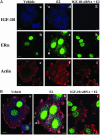The role of Shc and insulin-like growth factor 1 receptor in mediating the translocation of estrogen receptor alpha to the plasma membrane
- PMID: 14764897
- PMCID: PMC357054
- DOI: 10.1073/pnas.0308334100
The role of Shc and insulin-like growth factor 1 receptor in mediating the translocation of estrogen receptor alpha to the plasma membrane
Abstract
Our previous studies demonstrated that 17beta-estradiol (E2) rapidly induces the interaction of estrogen receptor alpha (ERalpha) with the adapter protein Shc, the translocation of ERalpha to the cell membrane, and the formation of dynamic membrane structures in MCF-7 breast cancer cells. The present study examined how E2 causes ERalpha to translocate to the region of the plasma membrane and focused on mechanisms whereby Shc and the insulin-like growth factor-1 receptor (IGF-1R) mediate this process. Shc physically interacts with IGF-1R in the plasma membrane, and E2 activates IGF-1R. We reasoned that ERalpha, when bound to Shc, would be directed to the region of the plasma membrane by the same processes, causing membrane translocation of Shc. We confirmed that E2 rapidly induced IGF-1R phosphorylation and demonstrated that E2 induced formation of a ternary protein complex among Shc, ERalpha, and IGF-1R. Knock down of Shc with a specific small inhibitory RNA decreased the association of ERalpha with IGF-1R by 87%, suggesting that Shc is a crucial molecule in the formation of this ternary complex. Confocal microscopy studies provided further confirmation of the functional roles of Shc and the IGF-1R in the translocation of ERalpha to the region of the membrane. Down-regulation of Shc, ERalpha, or IGF-1R with specific small inhibitory RNAs all blocked E2-induced mitogen-activated protein kinase phosphorylation. Together, our results demonstrate that Shc and IGF-1R serve as key elements in the translocation of ERalpha to the cell membrane and in the facilitation of ERalpha-mediated rapid E2 action.
Figures





Similar articles
-
Linkage of rapid estrogen action to MAPK activation by ERalpha-Shc association and Shc pathway activation.Mol Endocrinol. 2002 Jan;16(1):116-27. doi: 10.1210/mend.16.1.0748. Mol Endocrinol. 2002. PMID: 11773443
-
Long-term estradiol deprivation in breast cancer cells up-regulates growth factor signaling and enhances estrogen sensitivity.Endocr Relat Cancer. 2005 Jul;12 Suppl 1:S61-73. doi: 10.1677/erc.1.01018. Endocr Relat Cancer. 2005. PMID: 16113100
-
Tamoxifen interferes with the insulin-like growth factor I receptor (IGF-IR) signaling pathway in breast cancer cells.Cancer Res. 1997 Jul 1;57(13):2606-10. Cancer Res. 1997. PMID: 9205064
-
The role of adapter protein Shc in estrogen non-genomic action.Steroids. 2004 Aug;69(8-9):523-9. doi: 10.1016/j.steroids.2004.05.012. Steroids. 2004. PMID: 15288764 Review.
-
Requirements for estrogen receptor alpha membrane localization and function.Steroids. 2005 May-Jun;70(5-7):361-3. doi: 10.1016/j.steroids.2005.02.015. Epub 2005 Mar 25. Steroids. 2005. PMID: 15862818 Review.
Cited by
-
Extranuclear ERα is associated with regression of T47D PKCα-overexpressing, tamoxifen-resistant breast cancer.Mol Cancer. 2013 May 1;12:34. doi: 10.1186/1476-4598-12-34. Mol Cancer. 2013. Retraction in: Mol Cancer. 2017 Jul 17;16(1):121. doi: 10.1186/s12943-017-0697-5. PMID: 23634843 Free PMC article. Retracted.
-
Sustained proliferation in cancer: Mechanisms and novel therapeutic targets.Semin Cancer Biol. 2015 Dec;35 Suppl(Suppl):S25-S54. doi: 10.1016/j.semcancer.2015.02.006. Epub 2015 Apr 17. Semin Cancer Biol. 2015. PMID: 25892662 Free PMC article. Review.
-
Src promotes estrogen-dependent estrogen receptor alpha proteolysis in human breast cancer.J Clin Invest. 2007 Aug;117(8):2205-15. doi: 10.1172/JCI21739. J Clin Invest. 2007. PMID: 17627304 Free PMC article.
-
Direct recruitment of insulin receptor and ERK signaling cascade to insulin-inducible gene loci.Diabetes. 2011 Jan;60(1):127-37. doi: 10.2337/db09-1806. Epub 2010 Oct 7. Diabetes. 2011. PMID: 20929976 Free PMC article.
-
Is Estrogen a Missing Culprit in Thyroid Eye Disease? Sex Steroid Hormone Homeostasis Is Key to Other Fibrogenic Autoimmune Diseases - Why Not This One?Front Immunol. 2022 Jun 17;13:898138. doi: 10.3389/fimmu.2022.898138. eCollection 2022. Front Immunol. 2022. PMID: 35784325 Free PMC article.
References
-
- Yager, J. D. (2000) J. Natl. Cancer Inst. Monogr. 27, 67-73. - PubMed
-
- Pietras, R. J., Nemere, I. & Szego, C. M. (2001) Endocrine 14, 417-427. - PubMed
-
- Ho, K. J. & Liao, J. K. (2002) Arterioscler. Thromb. Vasc. Biol. 22, 1952-1961. - PubMed
-
- Collins, P. & Webb, C. (1999) Nat. Med. 5, 1130-1131. - PubMed
Publication types
MeSH terms
Substances
Grants and funding
LinkOut - more resources
Full Text Sources
Other Literature Sources
Molecular Biology Databases
Miscellaneous

